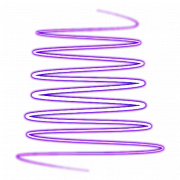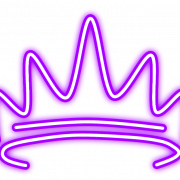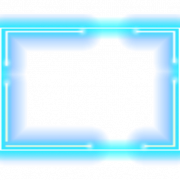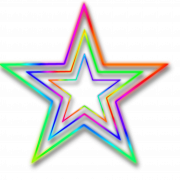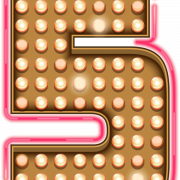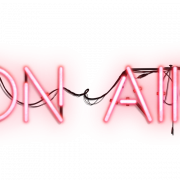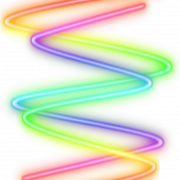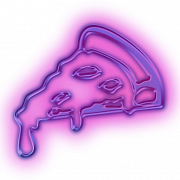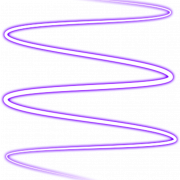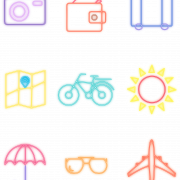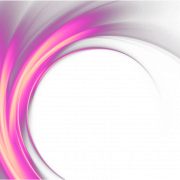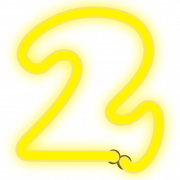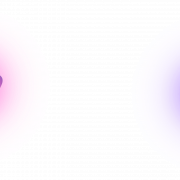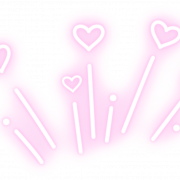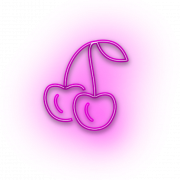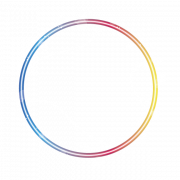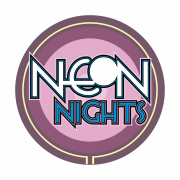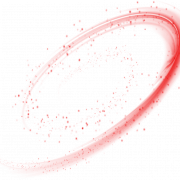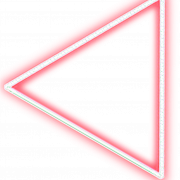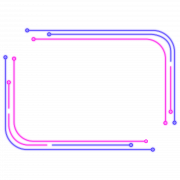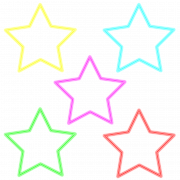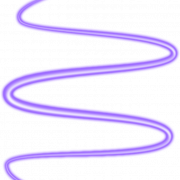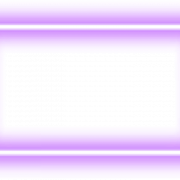Download top and best high-quality free Neon Element PNG Transparent Images backgrounds available in various sizes. To view the full PNG size resolution click on any of the below image thumbnail.
License Info: Creative Commons 4.0 BY-NC
Neon lighting consists of electrified glass tubes or bulbs that flash vividly and contain rarefied neon or other gases. Cold cathode gas-discharge lights, such as neon lights, are a form of cold cathode gas-discharge light. A neon tube is a sealed glass tube with a metal electrode at either end that is filled at low pressure with one of many gases. The gas in the tube is ionized by a high potential of several thousand volts given to the electrodes, causing it to produce colorful light.
The gas in the tube determines the hue of the light. Neon lights are called after neon, a noble gas that emits a bright orange light, but other gases and chemicals, such as hydrogen (red), helium (yellow), carbon dioxide (white), and mercury, are employed to generate various colors (blue). Neon tubes may be shaped into letters or images in a variety of creative forms. Neon signs, which were popular from the 1920s to the 1960s and again in the 1980s, are mostly made using them.
The phrase can also refer to the mini neon glow lamp, which was created in 1917, around seven years after neon tube lighting became popular. While neon tube lights are generally meters long, neon lamps can be as short as one centimeter and provide a considerably bluer glow than tube lights. They’re still used as tiny warning lights. Throughout the 1970s, neon glow lamps were widely employed in electronics as numerical displays, tiny ornamental lamps, and signal processing devices. While these lights are now considered antiques, the neon glow lamp’s technology is still used in modern plasma screens and televisions.
The British physicists William Ramsay and Morris W. Travers discovered neon in 1898. They investigated the characteristics of pure neon obtained from the environment using a “electrical gas-discharge” tube similar to the tubes used for neon signs today. At the Paris Motor Show, December 3–18, 1910, a French engineer and inventor, Georges Claude, demonstrated neon tube illumination in basically its contemporary form.
Claude, dubbed “France’s Edison,” had a near-monopoly on the new technology, which became popular for signs and displays between 1920 and 1940. In the United States at the time, neon lighting was a major cultural phenomenon; by 1940, virtually every city’s downtown was lit up with neon signs, and Times Square in New York City was famous for its neon extravagances. There were 2000 neon sign design and manufacturing businesses around the country.
Following World War II (1939–1945), the popularity, complexity, and size of neon signs for advertising dropped in the United States, although development proceeded apace in Japan, Iran, and a few other nations. Architects and artists, as well as sign designers, have reintroduced neon tube lighting as a component in their works in recent decades.
Fluorescent lighting, which emerged around 25 years after neon tube lighting, is closely connected to neon lighting. The light generated by rarefied gases within a tube is utilized solely to stimulate fluorescent materials that coat the tube, which subsequently shine with their own colors, resulting in the tube’s apparent, generally white glow. Fluorescent coatings and glasses are also available for neon tube illumination, although they are typically chosen for their vibrant hues.
Download Neon Element PNG images transparent gallery.
- Neon Heart PNG Image
Resolution: 850 × 638
Size: 283 KB
Image Format: .png
Download
- Neon Heart Transparent
Resolution: 850 × 766
Size: 520 KB
Image Format: .png
Download
- Neon Spiral PNG Clipart
Resolution: 1024 × 1024
Size: 1159 KB
Image Format: .png
Download
- Neon Heart PNG Clipart
Resolution: 850 × 636
Size: 446 KB
Image Format: .png
Download
- Neon PNG Clipart
Resolution: 900 × 900
Size: 137 KB
Image Format: .png
Download
- Neon Circle Transparent
Resolution: 1024 × 1024
Size: 469 KB
Image Format: .png
Download
- Neon PNG Free Download
Resolution: 1024 × 625
Size: 227 KB
Image Format: .png
Download
- Neon Circle PNG Clipart
Resolution: 1773 × 1773
Size: 1559 KB
Image Format: .png
Download
- Neon Square Transparent
Resolution: 700 × 541
Size: 179 KB
Image Format: .png
Download
- Neon PNG Picture
Resolution: 2400 × 1200
Size: 1369 KB
Image Format: .png
Download
- Neon Star PNG
Resolution: 1858 × 1752
Size: 260 KB
Image Format: .png
Download
- Neon Moon PNG
Resolution: 1024 × 1024
Size: 524 KB
Image Format: .png
Download
- Neon Heart PNG Free Download
Resolution: 850 × 779
Size: 432 KB
Image Format: .png
Download
- Neon Triangle PNG Picture
Resolution: 700 × 490
Size: 61 KB
Image Format: .png
Download
- Neon PNG HD Image
Resolution: 900 × 900
Size: 126 KB
Image Format: .png
Download
- Neon Square PNG Clipart
Resolution: 1024 × 1024
Size: 58 KB
Image Format: .png
Download
- Neon Number PNG
Resolution: 600 × 708
Size: 322 KB
Image Format: .png
Download
- Neon Number
Resolution: 600 × 823
Size: 399 KB
Image Format: .png
Download
- Neon Number PNG Image
Resolution: 600 × 878
Size: 571 KB
Image Format: .png
Download
- Neon PNG File
Resolution: 1024 × 576
Size: 774 KB
Image Format: .png
Download
- Neon PNG Free Image
Resolution: 1024 × 576
Size: 914 KB
Image Format: .png
Download
- Neon Triangle
Resolution: 600 × 600
Size: 319 KB
Image Format: .png
Download
- Neon Spiral
Resolution: 805 × 1025
Size: 1483 KB
Image Format: .png
Download
- Neon
Resolution: 1024 × 931
Size: 1961 KB
Image Format: .png
Download
- Neon PNG Pic
Resolution: 857 × 777
Size: 1428 KB
Image Format: .png
Download
- Neon Wings
Resolution: 1773 × 1773
Size: 1337 KB
Image Format: .png
Download
- Neon Spiral PNG
Resolution: 1024 × 1366
Size: 788 KB
Image Format: .png
Download
- Neon PNG Download Image
Resolution: 4142 × 4872
Size: 1689 KB
Image Format: .png
Download
- Neon PNG High Quality Image
Resolution: 853 × 805
Size: 680 KB
Image Format: .png
Download
- Neon Number Transparent
Resolution: 1744 × 1920
Size: 926 KB
Image Format: .png
Download
- Neon PNG Images
Resolution: 3121 × 1360
Size: 620 KB
Image Format: .png
Download
- Neon Heart
Resolution: 1446 × 1022
Size: 1001 KB
Image Format: .png
Download
- Neon PNG Image File
Resolution: 1272 × 697
Size: 763 KB
Image Format: .png
Download
- Neon Triangle PNG
Resolution: 873 × 800
Size: 605 KB
Image Format: .png
Download
- Neon PNG Photo
Resolution: 993 × 1025
Size: 447 KB
Image Format: .png
Download
- Neon Moon
Resolution: 753 × 1002
Size: 461 KB
Image Format: .png
Download
- Neon Wings PNG
Resolution: 1024 × 1024
Size: 696 KB
Image Format: .png
Download
- Neon Circle
Resolution: 792 × 612
Size: 78 KB
Image Format: .png
Download
- Neon Circle PNG
Resolution: 2400 × 2400
Size: 444 KB
Image Format: .png
Download
- Neon Circle PNG Image
Resolution: 1024 × 878
Size: 291 KB
Image Format: .png
Download
- Neon Triangle PNG Image
Resolution: 1024 × 1024
Size: 540 KB
Image Format: .png
Download
- Neon PNG Image HD
Resolution: 1024 × 1024
Size: 100 KB
Image Format: .png
Download
- Neon Wings PNG Image
Resolution: 1024 × 1024
Size: 610 KB
Image Format: .png
Download
- Neon Square
Resolution: 1024 × 1024
Size: 218 KB
Image Format: .png
Download
- Neon Triangle Transparent
Resolution: 1472 × 1704
Size: 1703 KB
Image Format: .png
Download
- Neon Square PNG
Resolution: 8334 × 8334
Size: 1187 KB
Image Format: .png
Download
- Neon Triangle PNG Clipart
Resolution: 700 × 700
Size: 185 KB
Image Format: .png
Download
- Neon Heart PNG
Resolution: 1272 × 1280
Size: 1576 KB
Image Format: .png
Download
- Neon Star
Resolution: 1280 × 1280
Size: 535 KB
Image Format: .png
Download
- Neon PNG File Download Free
Resolution: 1280 × 1218
Size: 363 KB
Image Format: .png
Download
- Neon PNG
Resolution: 720 × 720
Size: 187 KB
Image Format: .png
Download
- Neon Spiral PNG Image
Resolution: 929 × 620
Size: 198 KB
Image Format: .png
Download
- Neon Spiral Transparent
Resolution: 685 × 852
Size: 259 KB
Image Format: .png
Download
- Neon Square PNG Image
Resolution: 1084 × 702
Size: 160 KB
Image Format: .png
Download
- Neon PNG Image
Resolution: 1157 × 1280
Size: 812 KB
Image Format: .png
Download
- Neon Number PNG Clipart
Resolution: 820 × 880
Size: 124 KB
Image Format: .png
Download
- Neon Triangle PNG Free Download
Resolution: 1024 × 779
Size: 612 KB
Image Format: .png
Download
- Neon Transparent
Resolution: 1024 × 1766
Size: 792 KB
Image Format: .png
Download


